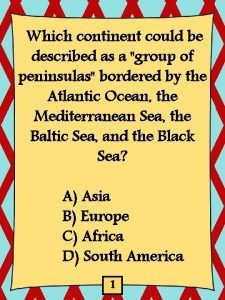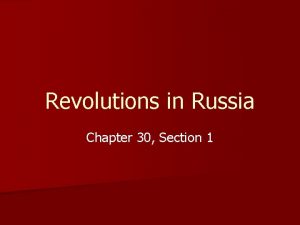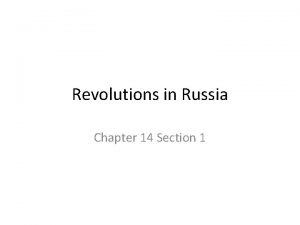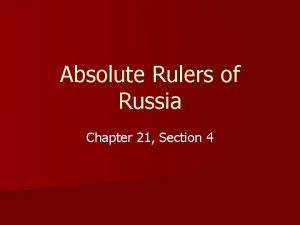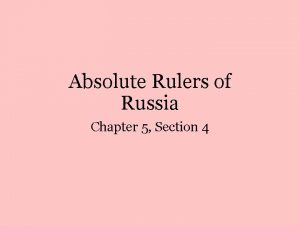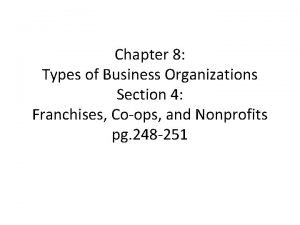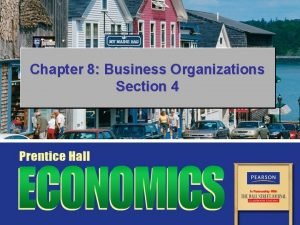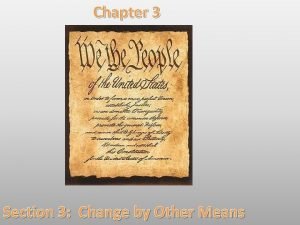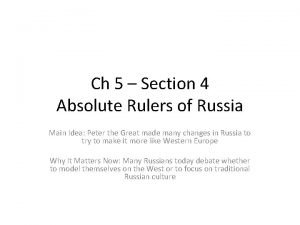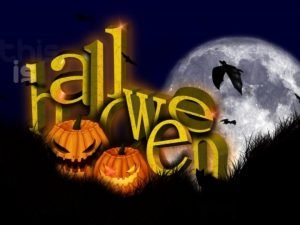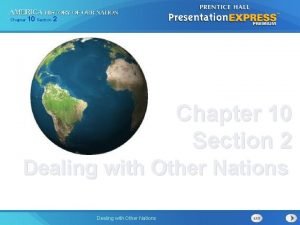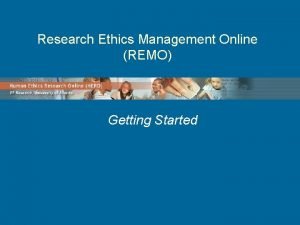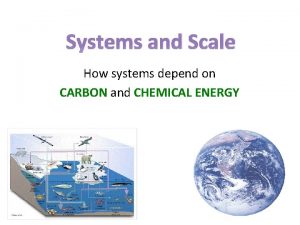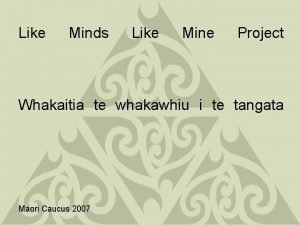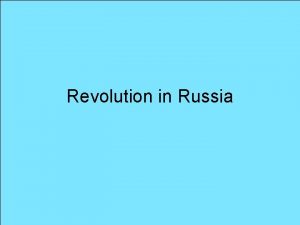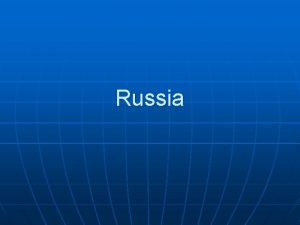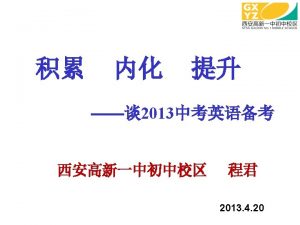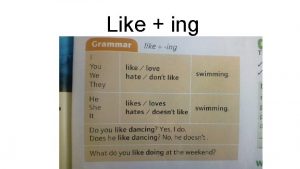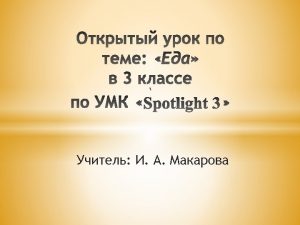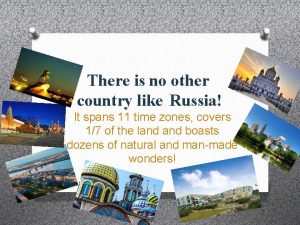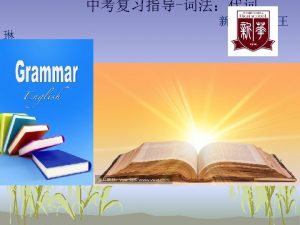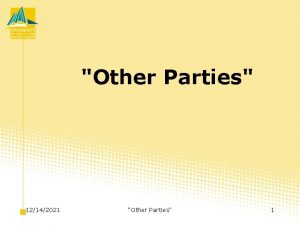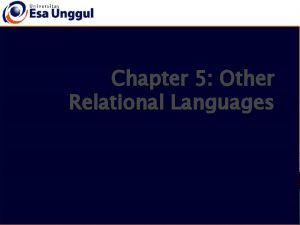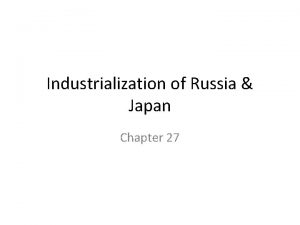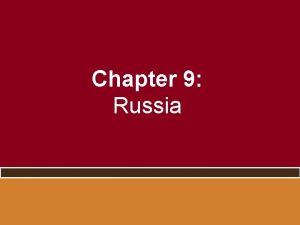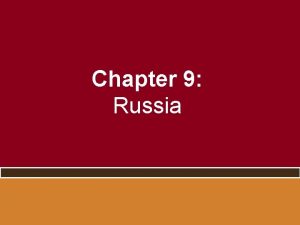CHAPTER 8 SECTION 5 Russia Russia Like other






















- Slides: 22

CHAPTER 8 SECTION 5 Russia

Russia Like other countries , during the 1500 and 1800, Russia made tremendous territorial gains and became a major European power. Unfortunately, Slavs elsewhere lost ground and were taken over by other powers. In southeastern Europe, the Ottoman Turks ruled most of the Balkan Peninsula and the Serbs, Bosnians, and Macedonians who lived there.

Under the Ottomans, some of the Slavs who lost ground or were taken over converted to Islam, while the rest remained Eastern Orthodox. Hungary ruled the Croats and Austria controlled the Slovenes. Both these Slavic peoples remained Roman Catholic and oriented to western Europe.

In central Europe, Austria ruled the Slovaks and Czechs. Ukraine was under Russian control. Poland was divided by Prussia, Austria, and Russia.

Rise of Russia was isolated from western European developments, such as the Crusades, the Renaissance, and the Reformation. They developed their own civilization based on the values of the Eastern Orthodox Church and the Byzantine Empire. The Russian monarchy became all powerful and easily crushed its opponents.

The nobility , the established church, and the towns-all of whom had posed repeated opposition to royal power elsewhere in Europenever posed the same challenge in Russia.

Ivan IV The most powerful of the early czars was Ivan IV, who ruled from 1533 to 1584. Known as Ivan “the Terrible” or “the Awesome, ” he was at once learned, religious, and cruel. Ivan became czar at the age of three. While growing up he witnessed much cruelty and was never able to rid himself of his early memories.

As an adult, Ivan saw treason everywhere and arrested, exiled, or executed many of his closest advisers. In a fit of rage, he even killed his own son. Ivan took many steps against the boyars, the nobles, to reduce their potential threat to his throne. He created his own secret police force and terrorized the country.

Ivan also increased his trade with western Europe and worked to expand his borders. Despite Russia’s vast size, it had few seaports free of ice throughout the year. Gaining more access to the sea for trade and security became a major goal of Russian rulers. Therefore, Ivan conquered Mongol lands east and south of Moscow.

The Time of Troubles After Ivan’s death, Russia drifted toward chaos. For example, there were noble feuds over the throne, peasant revolts, and foreign invasions that plagued the country (Time of Troubles) Finally, in 1613, an assembly of clergy, nobles, and townsmen named 17 year old Michael Romanov as czar. He began the Romanov dynasty that ruled Russia until 1917.

During the 1500 s and 1600 s, Russian society experienced many changes. Boyars became more closely tied to the czar’s service, townspeople lost what little influence they had on government, and peasants were bound to the land as a virtually enslaved workforce.

Peter the Great In 1689, Peter I, know as Peter the Great, came to the throne. During his reign he sought to bring Russia into the mainstream of European civilization. He sought out tutors among the foreign community in Moscow to learn the basic skills of navigation and shipbuilding. He discovered that Russian knowledge of the outside world was quite limited.

After becoming czar, Peter took an 18 month study tour of England the Netherlands. When he returned home, he forced the Russian nobility to adopt the ways of western Europe. Example: He ordered members of the court to wear western European clothing. Men entering Moscow were forced to shave their beards or pay a fine. Women, who had always been excluded from social gatherings, were ordered to attend parties.

In addition to these changes, he invited foreign experts to train Russians. His greatest effort to open Russia to Europe was the building of a new capital, which he named St. Petersburg. The capital was located at the mouth of the Neva River near the Baltic Sea, and it became Russia’s “window to the west. ”

Foreign Policy Peter’s goal was to make Russia a European power. Therefore he expanded the borders in the south, east, and northwest. He also forced China to accept Russian control of Siberia. He modernized the military and his reforms paid off when Russia defeated Sweden and won control of the eastern end of the Baltic region.

Government Administration People made sweeping changes in the Russian government. He introduced a central bureaucracy and placed local governments under its control. He brought the Eastern Orthodox Church under his direct authority and in place of a single independent church leader, he created the Holy Synod, a council of bishops responsible to the government. He created a new class of nobles called dvorianie, who, in return for government service, were allowed to own hereditary, landed estates.

Peter used privileges and force to make the established nobility accept government service. Nobles were given full control over serfs, or peasant land owners who worked the estates and were bound to the land. Finally, Peter changed the tax laws to increase government income and efficiency. Under the plan, nobles paid no taxes. The tax fell on the poorest class.

Economic Changes To stimulate economic growth, Peter brought agriculture and craft production under strict government control. He gave incentives to increase production in favored areas such as mining and metalworking. New production centers were provided with land, money, and workers.

Effects Peter’s reforms strengthened Russia’s role in foreign affairs. In his county, however, Peter had only limited success. His domestic policies broke the traditional Eastern Orthodox culture that had united nobles and peasants. With Peter’s reign, a dangerous split developed between the few who accepted European ways and the many who clung to traditional values.

Catherine the Great After Peter’s death in 1725, Russia was ruled by a series of weak or ordinary monarchs. The next notable ruler was Catherine II. She seized the throne form her weak husband, Peter III, and ruled as empress of Russia until 1796. Although born a German princess, Catherine easily adopted Russian ways and earned the respect of her people.

As monarch, she was greatly influenced by leading western European thinkers. She studied their work and corresponded with a number of them. She allowed nobles to treat their serfs as they pleased. During her reign, more peasants were forced into serfdom than ever before, and their conditions worsened. The common people of Russia had fewer rights than those in any other part of Europe.

A successful foreign policy earned her the name Catherine the Great. She significantly expanded Russia’s borders to the south and achieved the goal of securing a warm water port on the Black Sea. In making this gain, Russian armies defeated the Ottoman Turks. In the west, she acquired territory from Poland. Catherine was the last of the great absolute monarchs of the 1700 s. By the time of her death, new ideas of liberty and equality had spread throughout western Europe. These new ideas directly challenged and questioned the age old institution of monarchy.
 Which letter represents the pyrenees mountains on the map?
Which letter represents the pyrenees mountains on the map? Revolutions in russia chapter 30 section 1
Revolutions in russia chapter 30 section 1 Revolutions in russia chapter 14 section 1
Revolutions in russia chapter 14 section 1 Absolute rulers of russia section 4
Absolute rulers of russia section 4 Absolute rulers of russia section 4
Absolute rulers of russia section 4 Chapter 16 ap human geography
Chapter 16 ap human geography Chapter 21 section 4 absolute rulers of russia
Chapter 21 section 4 absolute rulers of russia Chapter 8 section 4
Chapter 8 section 4 Chapter 8 business organizations
Chapter 8 business organizations Chapter 3 section 3 change by other means worksheet answers
Chapter 3 section 3 change by other means worksheet answers Chapter 11 section 3 the implied powers
Chapter 11 section 3 the implied powers Types of positions
Types of positions Absolute rulers of russia section 4
Absolute rulers of russia section 4 Chapter 10 section 1: meiosis
Chapter 10 section 1: meiosis Haagen dazs tagline
Haagen dazs tagline Halloween falls on october 31 every year
Halloween falls on october 31 every year Section 2 dealing with other nations
Section 2 dealing with other nations Shaping evolutionary theory
Shaping evolutionary theory Prefer and would rather grammar
Prefer and would rather grammar I like you like it
I like you like it Which features of the sun look like huge cloudlike arches
Which features of the sun look like huge cloudlike arches Why does ethanol look like water but behave more like wood?
Why does ethanol look like water but behave more like wood? Like minds like mine
Like minds like mine
